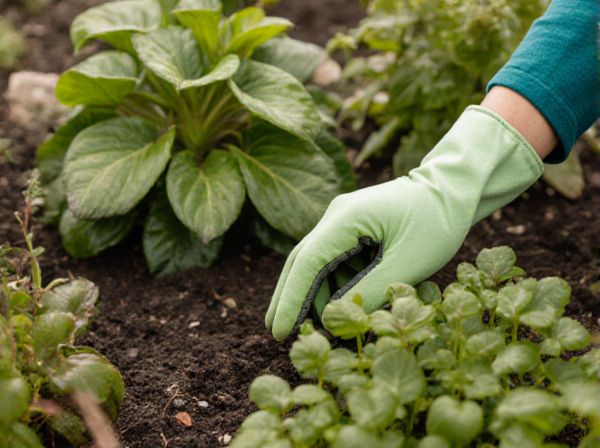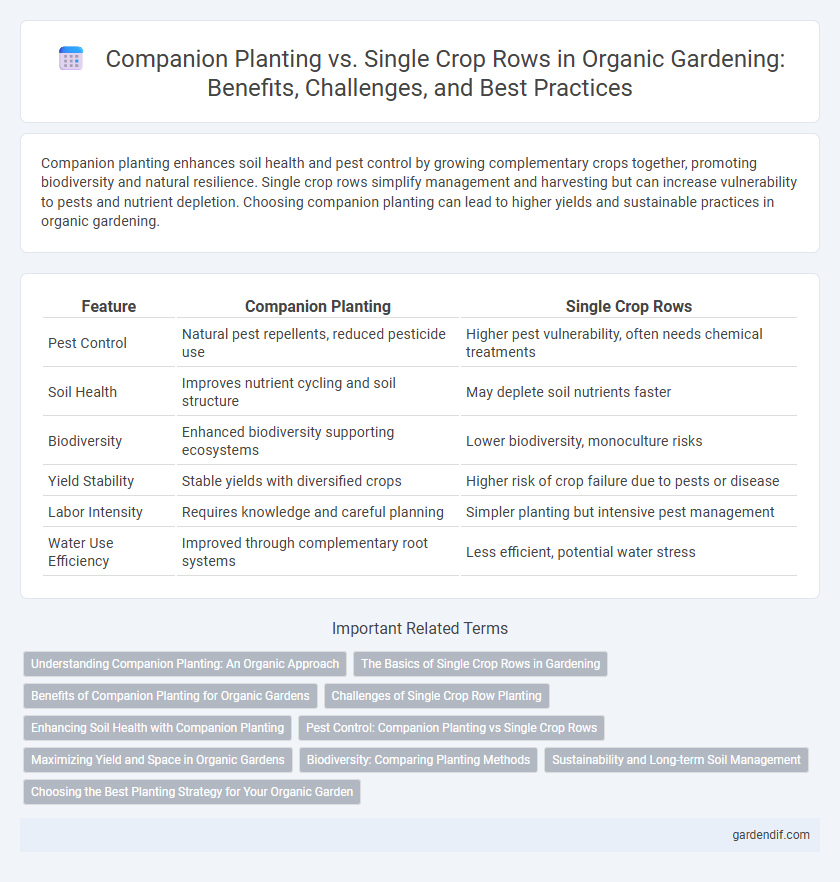
Companion planting vs Single crop rows Illustration
Companion planting enhances soil health and pest control by growing complementary crops together, promoting biodiversity and natural resilience. Single crop rows simplify management and harvesting but can increase vulnerability to pests and nutrient depletion. Choosing companion planting can lead to higher yields and sustainable practices in organic gardening.
Table of Comparison
| Feature | Companion Planting | Single Crop Rows |
|---|---|---|
| Pest Control | Natural pest repellents, reduced pesticide use | Higher pest vulnerability, often needs chemical treatments |
| Soil Health | Improves nutrient cycling and soil structure | May deplete soil nutrients faster |
| Biodiversity | Enhanced biodiversity supporting ecosystems | Lower biodiversity, monoculture risks |
| Yield Stability | Stable yields with diversified crops | Higher risk of crop failure due to pests or disease |
| Labor Intensity | Requires knowledge and careful planning | Simpler planting but intensive pest management |
| Water Use Efficiency | Improved through complementary root systems | Less efficient, potential water stress |
Understanding Companion Planting: An Organic Approach
Companion planting enhances organic gardening by promoting natural pest control, improved pollination, and optimized nutrient use through strategic plant pairings. Unlike single crop rows, which often suffer from depletion of specific soil nutrients and increased susceptibility to pests, companion planting fosters biodiversity and soil health. Key organic examples include pairing nitrogen-fixing legumes with heavy feeders like corn to boost soil fertility and using marigolds to deter nematodes alongside tomatoes.
The Basics of Single Crop Rows in Gardening
Single crop rows involve planting one type of crop in a dedicated section, simplifying pest management and soil nutrient monitoring. This method allows for targeted fertilization and irrigation, optimizing growth conditions for specific plants. Single crop rows also facilitate easier harvesting and crop rotation planning, enhancing overall garden productivity.
Benefits of Companion Planting for Organic Gardens
Companion planting enhances organic garden health by naturally deterring pests and promoting pollination through strategic plant pairings, reducing reliance on chemical pesticides. It improves soil fertility and structure by combining plants with complementary nutrient needs and root systems, leading to more efficient use of garden space and resources. This method supports biodiversity and resilience, creating a balanced ecosystem that fosters stronger plant growth and higher yields in organic gardening.
Challenges of Single Crop Row Planting
Single crop row planting often leads to increased vulnerability to pests and diseases due to a lack of plant diversity, which disrupts natural pest control mechanisms. Soil nutrient depletion occurs more rapidly because the same crop exhausts specific nutrients without the benefit of complementary planting. Weed pressure tends to be higher in single crop rows, resulting in increased labor and potentially greater chemical use to maintain crop health.
Enhancing Soil Health with Companion Planting
Companion planting improves soil health by increasing biodiversity, promoting beneficial microbial activity, and enhancing nutrient cycling compared to single crop rows. Intercropping legumes like peas or beans with vegetables naturally fixes nitrogen, reducing the need for synthetic fertilizers and improving soil fertility. Diverse root structures in companion planting help prevent soil erosion and improve aeration, leading to healthier, more resilient soil ecosystems.
Pest Control: Companion Planting vs Single Crop Rows
Companion planting enhances pest control by attracting beneficial insects and repelling harmful pests through diverse plant combinations, reducing reliance on chemical pesticides. Single crop rows often create uniform environments that enable pests to spread rapidly, increasing vulnerability to infestations. Integrating companion plants improves biodiversity and natural pest management, promoting healthier organic crop growth.
Maximizing Yield and Space in Organic Gardens
Companion planting enhances organic garden productivity by pairing mutually beneficial plants that improve nutrient uptake, pest control, and pollination, leading to maximized yield and efficient space use. Single crop rows, while simpler to manage, often waste space and reduce biodiversity, limiting growth potential and soil health. Utilizing companion planting strategies increases overall plant health and yields by optimizing resource sharing and reducing competition in limited organic garden spaces.
Biodiversity: Comparing Planting Methods
Companion planting enhances biodiversity by integrating diverse plant species within the same area, promoting natural pest control and improving soil health through complementary nutrient use. Single crop rows, while easier to manage, tend to reduce biodiversity and increase vulnerability to pests and diseases due to monoculture practices. Diverse ecosystems created by companion planting foster resilient agricultural environments, supporting beneficial insects and microbial activity.
Sustainability and Long-term Soil Management
Companion planting enhances sustainability by promoting biodiversity, improving pest control, and reducing the need for chemical inputs compared to single crop rows. It supports long-term soil health through natural nutrient cycling, nitrogen fixation, and increased organic matter, leading to improved soil structure and fertility. In contrast, single crop rows often result in soil depletion, higher erosion risk, and reliance on synthetic fertilizers, undermining long-term soil management goals.
Choosing the Best Planting Strategy for Your Organic Garden
Companion planting enhances biodiversity by pairing plants that mutually benefit each other through pest control, improved pollination, and nutrient sharing, making it ideal for organic gardens aiming to reduce chemical inputs. Single crop rows simplify cultivation and harvesting but often require more organic pest management efforts due to uniform vulnerability and higher disease risk. Evaluating soil health, pest pressure, and garden size helps determine whether the diverse, synergistic approach of companion planting or the straightforward, manageable layout of single crop rows best supports sustainable organic production.
Companion planting vs Single crop rows Infographic

 gardendif.com
gardendif.com